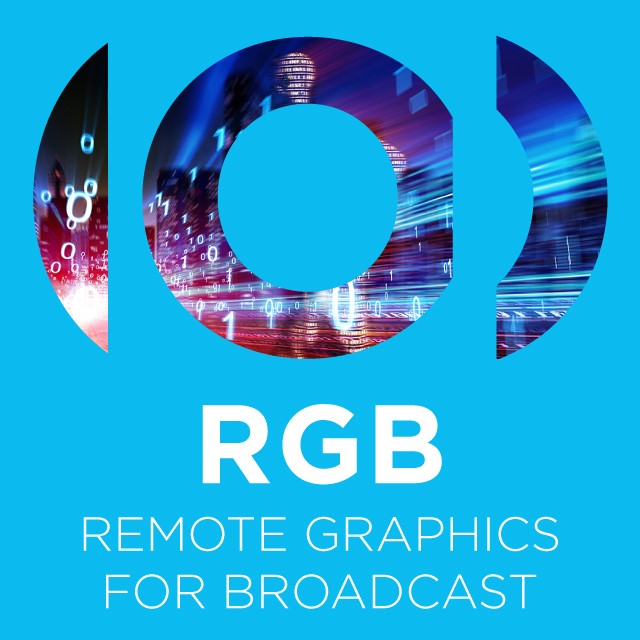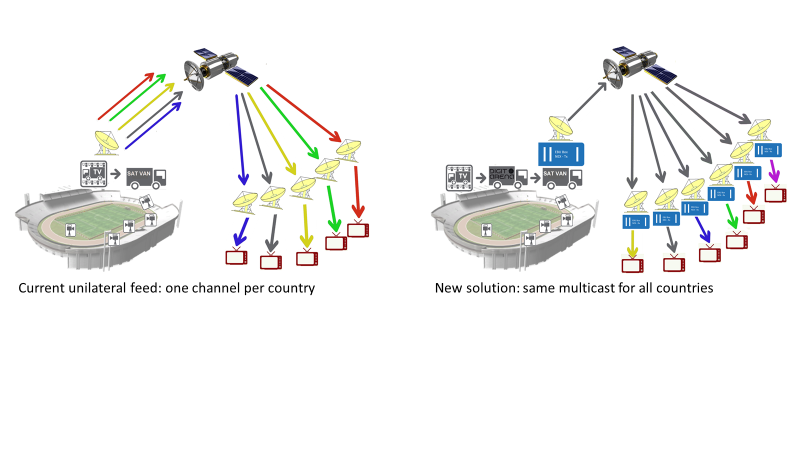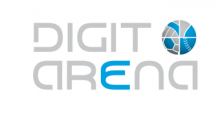
Objectives of the service
One of the main challenges for sports federations who have major events with international broadcast coverage has been working out how to adapt their TV graphics to improve fan engagement and make their content more accessible to audiences around the world.
Because TV production for sports events is usually centralised at the event venue, it is difficult to customise the TV graphics (e.g. language, units, sponsor logos) to meet the needs of local audiences in different geographical locations. Until recently, adding this level of personalisation was only possible for major events where several signal versions (unilateral feeds) at the origin were made available and delivered separately to rightsholders.
This was a costly, complex operation and only large, multinational companies could usually afford to sponsor such events. Audiences had to accept globalised, uniform content and event sponsors who could not afford to outbid their peers, had to forego having local advertisements.
Our newly developed remote graphics solution provides a way to centrally control the TV graphics at sports events and remotely render and insert them at the destination using one single uplink feed distributed across multiple geographical zones. This allows sports federations and event organisers to personalise the TV graphics to their local audiences, including local language and sponsors. For example, the name of a competitor could be shown in Latin, Cyrillic, Chinese or Arabic characters depending on the country of reception and the sponsor's logo can also be adapted to a nationally known entity rather than having the same display for all countries.
The cost of the transmission is shared between all of the events takers, thereby giving an advantage to national broadcasters over OTT. This model also gives sports federations the opportunity to increase the value of their events and attract more local sponsorship.
Users and their needs
- Broadcasters (country level)
- Need: When broadcasting an event, the associated graphics and texts are not adapted to the local language and sponsors, hence limiting our audience in terms of number of viewers. We need to adapt the TV graphics without having to request a dedicated feed to be produced and distributed directly to us.
- Value proposition: The remote graphics solution allows broadcasters to benefit from having a multicast distribution of the feeds to receive the personalised TV graphics and therefore expand their audience reach.
- Sports federations / content owners
- Need:We do not broadcast our events in certain countries because the audience is not sufficient due to language barriers, differences in measurement units and lack of local reference. This reduces the potential value of the events we organise.
- Value Proposition: The remote graphics solution allows sports federations and content owners to adapt TV graphical overlays to the local usages. The display of text in the local language, the display of speed or distances using the local units, presenting a local player’s through a video, will open the broadcast delivery to new countries, as people will finally understand “what is going on”.
- Sponsors
- Need: We want to adapt our brand exposure (TV graphics) to audiences in different geographical locations e.g. limit our sponsorship to specific locations based on our local branding strategies.
- Value Proposition: The remote graphics solution allows event sponsors to maximise local branding strategies by giving them an opportunity to choose which geographical regions they want to target/show their logos etc.
Service/ system concept
Eurovision Media Services, the business arm of the European Broadcasting Union, takes care of all of the uplink and downlink telecommunications. In our remote graphics solution, the unique satellite multicast signal is shared between all of the takers as well as the localisation of the content (see image below).

Prior to the event, during the low usage period of the satellite bandwidth, local stations upload their necessary local information, including graphical templates, local language tables and all of the necessary static event information.
During the event, the central Directors’ commands and the event's dynamic data are required to trigger the local graphics that are transmitted alongside the video contribution workflow on the transmission side. The graphical commands are then processed locally according to the local context (e.g. language, country, sponsorship).
We expect that our remote graphics solution will become the norm for sports events rather than the exception (e.g. it will be used not only for major events for a few content takers (e.g. max 6) but also for events of all kinds (e.g. up to 50 content takers). In addition, our solution provides an opportunity for content owners to increase sponsorship revenue for their events due to the possibility to better target the destination (local) markets.
Space Added Value
Satellite capacity is used extensively in order to contribute and distribute the live content feeds. As a result, it is a key element of the broadcast content distribution value chain. A key challenge in our project is to sustain the transport of graphics triggers, templates and data alongside the video feed over satellite distribution in perfect unison.
Current Status
The project has successfully delivered the two pilots as planned. The system proved to provide the expected technical and service value. As such we consider that all the objectives set originally have been met as we are entering now into the commercialization of the service with a first customer ready to start the onboarding procedures.
The main lesson learnt during the project has been around the complexity of the data mapping and understanding of the activation of the graphic chart. This lead to the conclusion that the process of onboarding the service within the distribution model of a content owner needs to be structured to ensure all required steps are delivered in a strong partnership with the content owner and its production partners.
Considering the fact lead time to transform an opportunity we have reached the conclusions that the service is now ready to be commercialise with a ramp up period of 8 to 10 months during which it is likely we will limit ourselves to onboarding a first customer.
Prime Contractor(s)
EBU / Eurovision Media Services
SwitzerlandSubcontractor(s)



